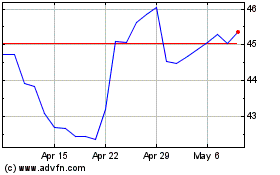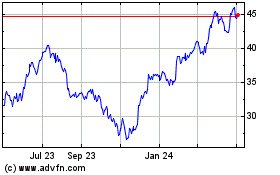GM Pulls Back Overseas and Drops an Australian Mainstay -- WSJ
February 18 2020 - 3:02AM
Dow Jones News
By Mike Cherney
This article is being republished as part of our daily
reproduction of WSJ.com articles that also appeared in the U.S.
print edition of The Wall Street Journal (February 18, 2020).
SYDNEY- -- General Motors Co. will scale back operations in
Australia, New Zealand and Thailand, its latest move to reduce
exposure in tough overseas markets while investing more in
autonomous and electric vehicles.
GM said Monday that it will stop selling and designing Holden
vehicles in Australia and New Zealand by 2021, marking the end of a
brand that began in the 1850s as a leather and saddle company and
now has some 1.6 million vehicles on the road. GM also said it
would stop selling Chevrolet vehicles in Thailand by the end of
2020, and is selling a manufacturing plant in Thailand to Great
Wall Motor Co., a Chinese company.
The move comes shortly after GM and other Detroit auto makers
offered tepid outlooks for 2020, following almost a decade of
steady sales growth around the world. China's once-booming car
market is expected to contract this year and the U.S. market could
also see a big decline. Investors, meanwhile, are betting that
electric-vehicle maker Tesla Inc. will capture a bigger slice of
the market in coming years.
GM said it would record total cash and noncash charges of $1.1
billion tied to the pullback from Australia, New Zealand and
Thailand, and that those charges would be primarily incurred in the
first quarter. More than 500 people in Australia and New Zealand
are expected to lose their jobs, company officials said.
Holden has been part of GM for nearly 100 years, but the brand
has struggled despite the heritage. In January, Holden captured
3.7% of the Australian new-vehicle market, compared with 5.1% from
the same month last year, according to the Federal Chamber of
Automotive Industries. Industrywide, Australian new-vehicle sales
declined more than 12% in January.
Holden's top-selling vehicle in Australia in December 2019 was
the Colorado, a pickup-style vehicle known as a "ute" in Australia.
Still, it was only the 15th bestselling vehicle in the country,
which was topped by another pickup truck, the Toyota HiLux.
GM said it couldn't come up with a plan that would make Holden
competitive and deliver an appropriate return on investment, citing
the highly fragmented market for vehicles in countries where
motorists drive on the left side of the road. Holden closed its
last Australian car factory in 2017, around the same time as other
global auto makers such as Ford Motor Co. and Toyota Motor
Corp.
"We chased down every conceivable option, every strategy, every
plan," GM Holden Interim Chairman and Managing Director Kristian
Aquilina said Monday. "We tried everything to keep Holden going
until it was evident it would take good money after bad."
GM said it planned to have a small specialty-vehicle business in
Australia and New Zealand, but didn't offer details on which of its
brands it may sell. For existing Holden customers, it said it would
honor all warranties and servicing offers made at the time of sale,
and that it would provide spare parts for at least 10 years.
Officials didn't specify how much investment would have been
required to justify continuing Holden's operations.
During a Feb. 5 investor conference, GM executives said they
aimed to improve operating profit in the company's international
operations -- which includes South America, the Middle East and a
handful of Asian markets, but not China -- by $2 billion in coming
years. The division lost more than $1 billion last year.
Over the course of Chief Executive Mary Barra's six-year tenure,
GM has exited or scaled back operations in many foreign markets,
including India and Europe, where GM sold its Opel and Vauxhall
brands to French car maker PSA Group in 2017. Ms. Barra has said
she wants to focus on markets where GM has a dominant position,
notably North America and China.
The company is shrinking its global footprint in part to free up
capital for bets on electric and autonomous vehicles and other
advanced technologies. GM is among the most aggressive traditional
auto makers in pursuing battery-powered vehicles, with plans to
have about 20 electric-vehicle models on sale globally within three
years. It also has been spending roughly $1 billion a year to
develop driverless cars through its San Francisco-based Cruise
subsidiary.
--Mike Colias contributed to this article.
Write to Mike Cherney at mike.cherney@wsj.com
(END) Dow Jones Newswires
February 18, 2020 02:47 ET (07:47 GMT)
Copyright (c) 2020 Dow Jones & Company, Inc.
General Motors (NYSE:GM)
Historical Stock Chart
From Mar 2024 to Apr 2024

General Motors (NYSE:GM)
Historical Stock Chart
From Apr 2023 to Apr 2024
